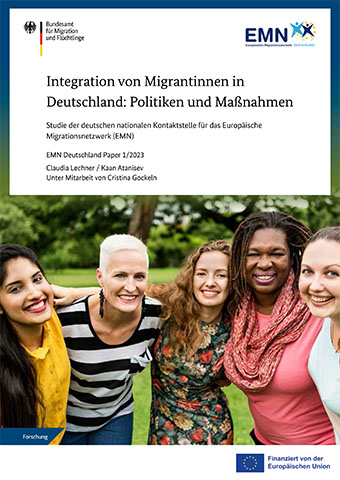Integration of Migrant Women in Germany: Policies and Measures , , Study of the National Contact Point Germany for the European Migration Network (EMN)
 Source: BAMF (cover image: AdobeStock | Rawpixel Ltd.)
Source: BAMF (cover image: AdobeStock | Rawpixel Ltd.)
The EMN Germany Paper focuses on the integration of migrant women in Germany. It provides an overview of the state of integration of migrant women, the associated challenges and the political approaches to integration in Germany.
The areas of integration considered in this study focus mainly on the fields covered in the EU Action Plan for Integration and Inclusion 2021-2027, including education and language, employment, health, housing, and additionally political and civic participation. In line with EMN requirements, the study primarily defines migrant women as third-country nationals. However, since the data base in Germany does not consistently allow for a distinction by third-country nationality and gender and, moreover, not all integration measures are designed only explicitly for third-country nationals, this study also presents those research findings and integration measures that refer generally to women with a migration background and thus implicitly include third-country nationals.
Integration of migrant women in key areas
In 2021, there were around 3.2 million women who were third-country nationals living in Germany and just under 11 million women with a migration background. A large proportion of them have their own migration experience. Residence permits for migrant women are mostly granted for family reasons as well as reasons of international law, humanitarian and political reasons. Overall, migrant women represent a heterogeneous group in terms of region of origin and residence permit.
This heterogeneity is also reflected in their different educational qualifications. While there are hardly any educational differences between women and men who are third-country nationals, there is an educational disparity in comparison with persons without a migration background. However, despite similar educational and vocational qualifications, female migrants participate in the labour market significantly less often than male migrants: The employment rate for third-country national women was only about 44 percent in 2021, compared with 67 percent for men. The study attributes this participation gap to two main factors.
Integration challenges
First, it is evident that migrant women often have qualifications in education, childcare and health professions, but are unable to use them in Germany due to high recognition requirements. This makes it difficult for migrant women to access skilled employment and results in a significantly lower employment rate overall. Second, in addition to the lack of recognition of degrees and qualifications, the lack of childcare facilities is a key hurdle in the labour market integration of migrant women. This dilemma of work-life balance also has a negative impact on their ability to participate in integration and language courses. In the areas of housing, health and political participation, the study identifies an additional need for empirical research, as there is a lack of in-depth knowledge on the integration of migrant women, especially with regard to the interaction of gender and migration background. Overall, however, the study shows that hurdles such as care and household responsibilities as well as a lack of language skills also have a negative impact in other areas of integration. Restricted legal opportunities (voting rights), for example, have an inhibiting effect on political participation.
Integration policies with regard to migrant women
Furthermore, the study describes how gender-specific integration challenges are addressed in integration strategies and measures. For example, the study shows that the Federal Government's overall integration policy concept, the National Action Plan on Integration (NAP-I), focuses on the resources and abilities of female migrants and their potential. Thus, not only problems regarding the access of migrant women to the labour market are highlighted, but also the special need for qualification-related counselling and job placement for highly qualified migrant women. A key integration goal is to increase the labour force participation of migrant and refugee women, which is promoted, for example, through programs such as "Stark im Beruf". The Federal Government's integration strategy covers a wide range of areas, including language teaching, integration into work and education, and social integration (e.g., in the form of the integration course). The integration course forms the core of the Federal Government's integration measures; here, the BAMF also offers special integration courses for women and parents, which take into account the special circumstances and care responsibilities of this group when designing the courses.
This study represents the German contribution to the EU-wide comparative EMN study "Integration of Migrant Women in the EU: Policies and Measures" and is only available in German. It is conducted according to common specifications in all participating EU Member States and Norway and provides an overview of integration policies and measures related to migrant women. The EU-wide comparative EMN study is available in English. In addition, there is a compact EMN Inform and a one-page EMN Flash on this topic, also in English (see "Downloads" under "Further Information").
The study was authored by: Kaan Atanisev and Claudia Lechner
The national study is only available in German.

